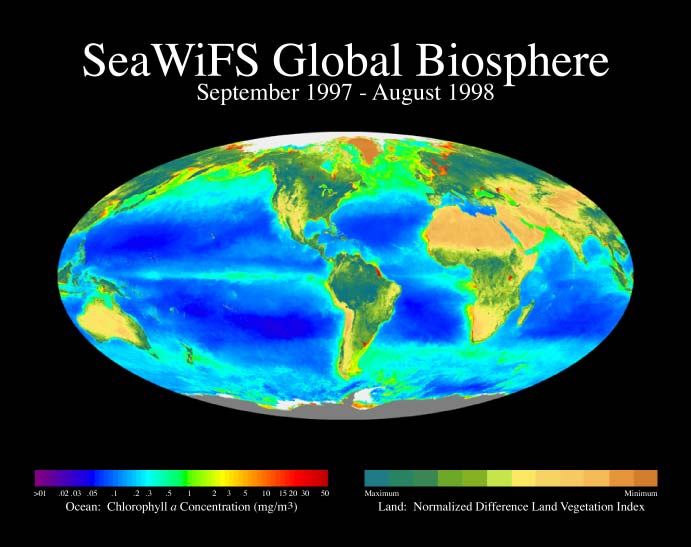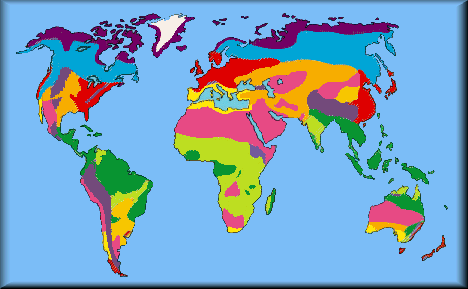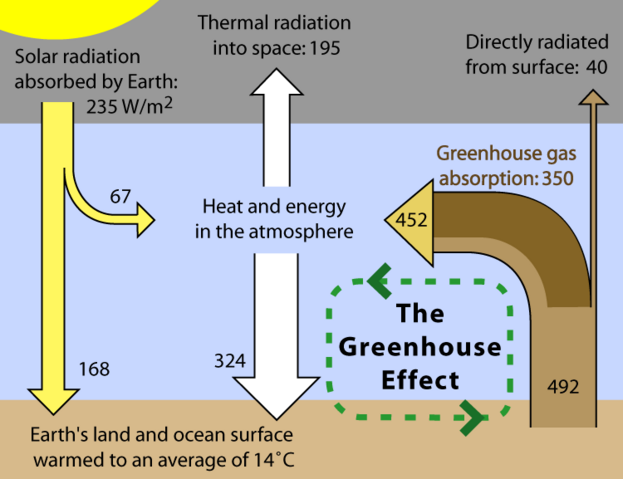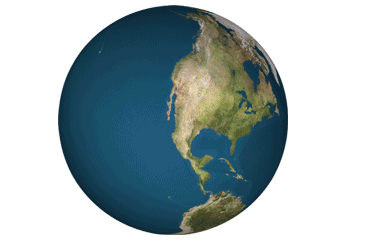Ocean conditions and the role of the biosphere on Earth
![]()
What is the biosphere?
Green shades on the global map indicate actively photosynthesizing plants.
In many ways the biosphere is a place to begin the study of life.
Marston Bates | functional indicator | systematic role | Gopher Tortoise | John & William Bartram | energy | conclusion | sources
Earth's rarity; the Biosphere
Marston Bates The Forest and the Sea
"But let's try to look at the biosphere without thinking of too much about the special case of man – try to see something of the many different kinds of patterns that go to make up the grand design. "
". . . start with the sea –and then look more closely at a special aspect of the sea, the coral reef."
p. 42.
"Of the three basic divisions of the biosphere, then, the sea is the oldest. . . . the most natural environment for life, the easiest environment."
p. 36.
Bates, Defining the biosphere.
Three Chapters:
The Study of Life, pp. 3-14.
He says naming a thing is very satisfying to people.
But where does it live and what does it do?
p. 4.
Revolutions in our understanding have changed what we know about humans and life on earth
- Hutton in Geology said that the earth is very, really, quite old!
- Darwin revolutionized how to think about life because of natural selection, behavior, and emotions.
Humans remain a paradox because we are important despite being one of millions of species.
p. 5.
Biology was invented in only 1809.
What is the creature's role in the "economy of nature?"
p. 6-7.
Plants are the basic organisms in the "Economy of Nature".
We humans are living with nature so it is wise to ask "Where do we fit in?"
p. 14.
Landscapes and Seascapes, pp. 15-27.
Bates describes the vast Llano grasslands of Venezuela and Colombia in South America.
He contrasts these seasonally dry areas with the Amazon mountain cloud forests
pp. 15-16.
He makes an analogy between the forests and the Sea
p. 17.
Bates argues that there exists an essential unity due to: "similarities in plan and function."
p. 18.
he compares the insects in a forest to the plankton in the seas with regards to their functional role in natural history.
p. 20.
He insists the physical properties of water make life possible in both settings.
p. 21.
"Life reaches its greatest diversity in tropical seas and tropical forests."
". . . They must have some way of getting water back. . . . ."
P. 23.
The Living World. pp. 28-42.
Bates marvels at the continuity of life
Look first at the Biosphere:
"Only at the surface are the chemical and physical conditions appropriate for life's development."
p. 30.
He subdivides the biosphere into three basic units: 1) Seas, 2) the Land, 3) Freshwater
p. 30.
He explains the basic similarities of the sea's margins and examines an atoll (coral island) called Ifaluk
 Located in the Caroline Islands, this small place where "the distinction between land and sea seemed to lose its biological meaning. We could find no logical way of subdividing the environment into a series of discrete biological communities and we came to the conclusion that he meaningful community included the whole atoll situation: land, reef, lagoon, and immediately surrounding sea."
Located in the Caroline Islands, this small place where "the distinction between land and sea seemed to lose its biological meaning. We could find no logical way of subdividing the environment into a series of discrete biological communities and we came to the conclusion that he meaningful community included the whole atoll situation: land, reef, lagoon, and immediately surrounding sea."
p. 31.
Defines the biosphere,
"The biosphere then is essentially continuous in space, a single interwoven web of life covering the surface of our planet. But it is far from being a uniform, monotonous web:it is woven into a motley series of patterns and designs."
p. 32.
"The biologist has, on the one hand, the problem of finding uniformities, the underlying motifs common to all of the patterns; and on the other hand, of finding and describing the divergencies, the meaning of the variations, the characteristics of the separate designs that have gone into making the web."
p. 32.
"The discovery of viruses –of life apparently in fluid form, or in the form of semi-microscopic, molecule-like particles– opened questions again."
p. 33.
"But all the viruses we know are parasitic. . ."
p. 34.
"Life, to be sure, is a consequence of environmental conditions at the earth's surface, but this environment, at the same time, is to a considerable degree affected by life processes."
p. 34-35.
"It is now thought, for instance, that the atmosphere of the earth, before life appeared, probably contained no oxygen and no carbon dioxide: that these gases that we think are essential for the existence of life, are the products of life."
Oxygen is renewed every 2000 years and carbon dioxide every 300 years
p. 35.
Marston Bates | functional indicator | systematic role | Gopher Tortoise | John & William Bartram | energy | conclusion | sources
The biosphere is a generalized term with specialized significance referring alternatively to:
Š A collection of living things that is planetary in scope, {for more details – See Vaclav Smil}.
Š A diverse array of interdependent and competing species,
Š A set of unfathomable, extensive, contingent, and very complex ecosystems,
Š Ecosystems that are dependent upon keystones species such as the kelp forests depending on sea otters eating sea snails,
Š Keystone species sustain far more than they appear to such as crabs and mangrove forests,
Š Collapse can occur with little or no warnings,
o California anchovy fishery,
o Grand Banks cod fishery,
o droughts in the SAHEL,
§ Sahara Desert's southern savannah forest ecotone,
§ deforestation due to charcoal use,
o coral bleaching with a loss of nearshore fisheries,
o declining Pacific plankton levels,
§ phytoplankton [floating plants] creates oxygen and absorbs carbon dioxide,
§ calcium carbonate accumulates [carbon rich sediments] in the deeper seas from coccolithophores.
So what do the oceans have to do with biological stability?
Oceans are one of the two cycles of the Earth's heat engine. By transferring heat and cold more uniformly around the planet and moderating the temperature of the earth the Oceans' greater mass warms and cools far more slowly than the surrounding land mass because of the capacity of water (high specific heat) to retain thermal radiation.
More different forms of life inhabit the oceans and the edges of the seas than those that inhabit the dry land.
Ocean levels rise and fall with the accumulation of heat trapping gas and the spread of ice sheets.
Life, especially plant life and bacteria, use heat trapping gases to metabolize and thus absorb and release thermal regulating compounds in the oceans and air.
Another answer.
In warmer areas with topographical variety the biological diversity is greater than in comparably sized areas in the temperate and polar latitudes.
Marston Bates | functional indicator | systematic role | Gopher Tortoise | John & William Bartram | energy | conclusion | sources
1. we cannot separate out useful versus useless species without disrupting or disturbing ecological systems
2. population disturbances should be read as warnings
Deer increase due to predator removal
Elephant herd increases due to loss of territory
3. the roles of lichens, fungus and viruses become exaggerated due to:
abrupt changes in land use patterns
deforestation
thermal pollution
acid conditions
cloud forest demise due to shifting altitudes of cloud cover
ENSO - El Nino / La Nina southern ocean oscillation patterns
Biomes of the world are major subdivisions of the biosphere with broadly similar climates & rainfall patterns.
1) a warning light, something that controls or limits functions
2) a pilot light, something that triggers a larger response or ignites the full system
3) an enunciator or indicator something that can reveal operating conditions
in this system the biosphere in part or as a whole acts in different roles.
Role The Earth's:
Heat Trap torrid zones surround the equatorial bulge
Air Conditioner the Arctic ocean and ice cover acts to cool the planet
Thermostat CO2, carbon dioxide acts to warm the planet
Alert (signal) light keystone species in biosphere’s ecotones act as warning flag.
Marston Bates | functional indicator | systematic role | Gopher Tortoise | John & William Bartram | energy | conclusion | sources
The biosphere is –
"The biosphere, to a casual glance, is varied enough, broken into oceans and continents, into forests and grasslands,rivers, lakes, bays shallow seas, and abyssal depths. The essential unity of the biosphere, however, emerges when we start to classify these variations. Every classification becomes in some sense arbitrary since it is an attempt by the human mind to impose categories on a continuous system."
"This is because we are not dealing with discrete, independent entities. We are not counting apples and pears and oranges; we are trying to measure the garden with a yardstick with no agreement about the size of our inches."
Marston Bates, p. 30.
A) Mass of diverse, living tissue
B) Electromagnetic absorption, thermal conduction, and pumping water
C) bacteria and plants are producers -- trap light and produce two effects:
C.1) keeps the Oxygen HI {high}(+) & the CO2 LO {low}(–)
C.2) acting as a buffer
These bacteria, fungi and plants "feed off of one another" creating an ever-enduring circuit of energy
Life shapes planet Earth's habitats as the Earth affects life on its surface and in the oceans in a reciprocal relationship.
The terms reciprocal relationship in that phrase means that one thing is contingent upon another, or in linking one creature to another both are tied to the success of the other.
For example, shown here is the Gopher Tortoise is a tunnel digger in the sand and numerous other creatures find refuge in its tunnels.
The Gopher Tortoise is called Gopherus polyphemus scientifically speaking and is native to the dry regions of the southeastern United States, wherein the loss of habitat to farms. roads, settlements and deforestation have had an adverse effect on the size of their dwindling populations. Specialists have argued that as many as 360 other species share the burrows of this avid digger. (Source: Gopher Tortoise Council) Very much like humans the animal is not sexually mature until it is a teenager. Though it lays many eggs females only lay once a year, but unlike humans, the species is declining. Despite the ease of relocating the Gopher Tortoise to new sandy conditions where it could thrive out of harms way, the animal is an herbivore eating a wide range of plants that thus influence its chances of living to t expected age of sixty or more years. As habitat shrinks in the dry upland (choice places for suburban development and planting fruit tree groves), the animals that depend on the Gopher Tortoise burrows are in danger of losing their homes as well.
The naturalist and explorer William Bartram is said to have named the Gopher Tortoise on his second trip to the Carolinas and Florida from 20 March 1773 until his tour of Northeastern Florida ended on New Year's 1777. (Sources: USF Natural History Museum, and Travels . . . pp. 18 & 180.) Bartram writes that "The dens or caverns dug in the sand hills, by the great land tortoise, called here Gopher, present a very singular appearance: their vast caves are their castles and diurnal retreats from whence they venture forth at night in search of prey." However they are not carnivores William had originally accompanied his father, John Bartram, the King's Botanist, on a tour of the same region from 1765 until March 1766.
Marston Bates | functional indicator | systematic role | Gopher Tortoise | John & William Bartram | energy | conclusion | sources
Circuit of energy means –
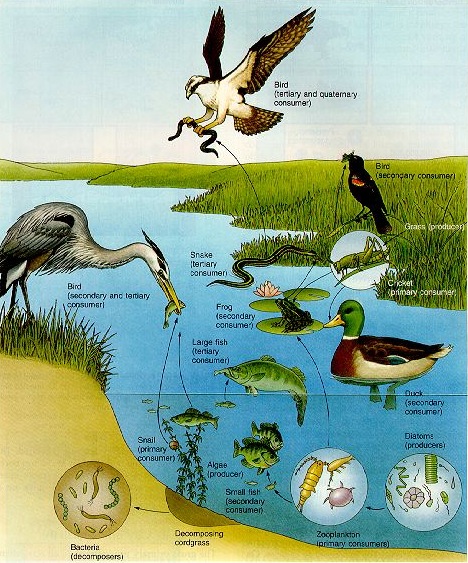
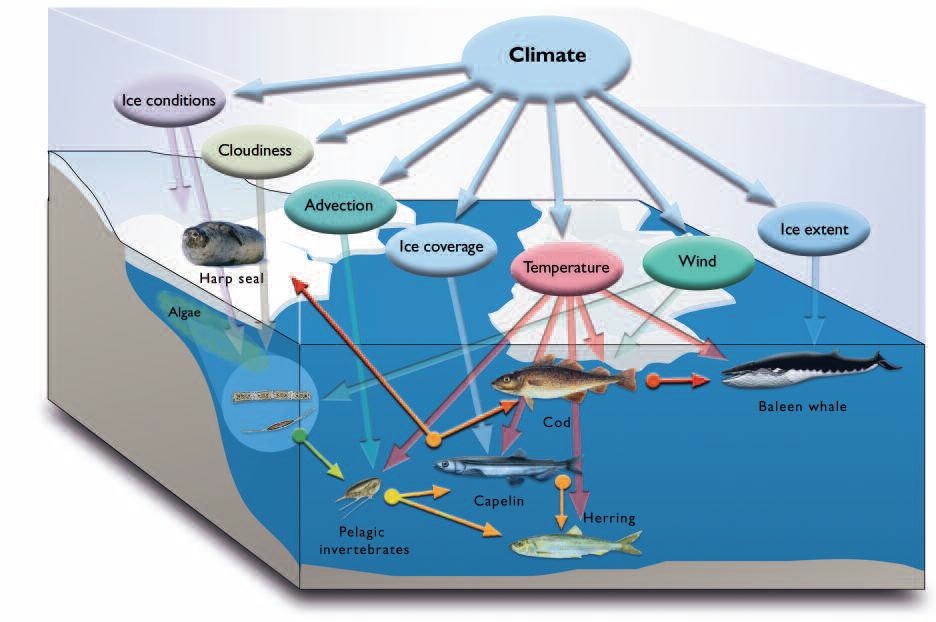

One creature feeds off of the life of another in an enduring, ever "revolving fund of life" called predation.
Thus, when we look at the biosphere as a whole, we find an essential unity. When we go to analyze this, we find we can recognize essential differences among the environments of the sea, the land, and the freshwater, despite the many ways in which these environments, and the organisms living in them blur."
Bates, p. 37.
Carbon's crucial, central role
1.
William Bartram, Bartram's Travels (1791)
xxxiv, 522 p., ill.
PHILADELPHIA:
PRINTED BY JAMES & JOHNSON.
M, DCC, XCI.
2.
Marston Bates, The Forest and the Sea (New York: Random House, 1959), pp. 1-42.
Marston Bates | functional indicator | systematic role | Gopher Tortoise | John & William Bartram | energy | conclusion | sources
Archer | Christianson | Gelbspan | James Hansen, 04 : Hansen 06 | Leggett | McKibben | Musil | Schmidt | Weart
